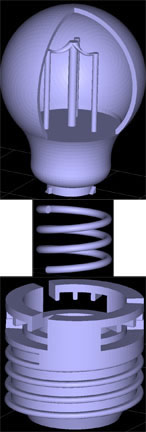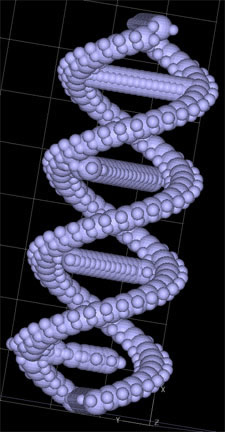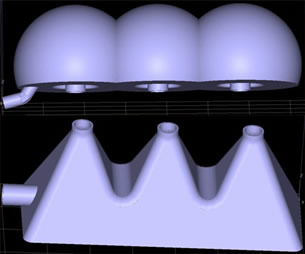Nine Finalists Announced in 2007 Extreme Redesign Contest
Winners of Dimension 3D Printing Group's competition to be announced at opening of RAPID 2008 conference.
Latest News
May 8, 2008
By DE Editors
 “Triple Play Light Bulb,” by Zach Stephens. CAD program used: Inventor Professional 2008. |
The Dimension 3D Printing Group (Minneapolis, MN), a business unit of Stratasys, Inc. (Eden Prairie, MN), announced the nine finalists for its fourth annual Extreme Redesign: The Ultimate 3D Printing Challenge, a global design and 3D printing contest for high school and college students.
The nine finalists were chosen from a pool of more than 800 design entries worldwide. Entries fell into one of three categories: “High School,” “University,” and the newly added “Art and Architecture.” The three first place category winners will receive $2,500 scholarships. The remaining finalists each will receive $1,000 scholarships.
The final contestants from the High School engineering category are Ashley Bredemus (entry titled “Rubik’s Sphere for the Blind”) of Grand Rapids High School in Grand Rapids, MN; Kyle Olbrich (“The Eggcinerator”) of Wando High School in Mt. Pleasant, SC, and, in his second consecutive year as a finalist, Zach Stephens (“Triple Play Light Bulb”) of Westfield High School in Carmel, IN.
Final contestants from the University engineering category are Ashley Lemon (“Public Seating”) of the Minneapolis College of Art and Design in Minneapolis, MN.; Nate Moren (“Flat Door Stop”) of the Minneapolis College of Art and Design in Minneapolis, MN.; and George Suarez (“Solar Powered Water Desalination Unit”) of the University of California Davis in Davis, CA.
Final contestants in the Art and Architecture category are Benjamin Foley (“Redesigned Lave Lamp”) of Sherwood High School in Sherwood, OR; Nicole Redcross (“Mrs. Redcross 2226”) of Metro Technology Centers in Oklahoma City, OK.; and Essiah Underwood (“Bfly Fan”) of Metro Technology Centers in Oklahoma City, OK.
 Mrs. Redcross 2226,” by Nicole Redcross. CAD program used: AutoCAD 2008. |
To enter the High School or University engineering categories, students need to identify an existing product and redesign it, making the original design better by adding new functionality or aesthetic qualities. For submissions in the Art and Architecture category, the emphasis should be on originality and the overall beauty or aesthetic of the design.
Once the design is complete, students submit an .stl file of their extreme redesign, a completed submission form, and a 200-word description of the value and benefit of the extreme redesign part via Dimension’s website.
A panel of independent judges then scores final entries on the basis of creativity, usefulness, part integrity, and beauty.
The three 2007 contest winners will be announced Tuesday, May 20 at the opening of the Society of Manufacturing Engineers’ (SME) RAPID 2008 Conference and Exposition in Lake Buena Vista, FL. Immediately following the announcement, an in-depth web video profiling the three winning students and their designs will be loaded to www.dimensionprinting.com.
Short web videos introducing the nine finalists and video, photos, and descriptions of last year’s winning extreme redesigns are available here. Design concepts from previous winners include a lighted retractable dog leash, an off-road cell phone carrier, and a solar powered-lighted street sign. Though an independent panel of judges determines the winners, Dimension encourages students, educators, and designers to vote for their favorite entries online.
 “Thermoelectric Water Desalination Powered by Photovoltaics,” by George Suarez. CAD program used: AutoCAD 2000. |
For further information on SME’s Rapid 2008 Conference and Expo visit www.sme.org.
The Dimension 3D Printing Group (www.dimensionprinting.com) is a business unit of Stratasys, Inc. (www.stratasys.com). Dimension 3D printers, which include the Elite and the Dimension 1200es and Dimension 768 series, are networked, desktop-modeling systems that allow computer-aided design (CAD) users to build functional 3D prints using durable ABS plastic.
Sources: Press materials received from the company and additional information gleaned from the company’s website.
Subscribe to our FREE magazine, FREE email newsletters or both!
Latest News
About the Author
DE’s editors contribute news and new product announcements to Digital Engineering.
Press releases may be sent to them via [email protected].






